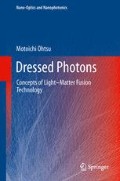Abstract
This chapter presents theoretical formulations of the coupling between dressed-photons (DPs) and phonons based on the physical picture of DPs reviewed in Chap. 2. After showing some novel phenomena involving photo-dissociation of molecules, a theoretical model for the interaction between DPs and phonons is described.
Mihi contuenti semper suasit rerum natura nihil incredibile existimare de ea. Caius Plinius Secundus Major, Naturalis Historya, XI, 2.
Access this chapter
Tax calculation will be finalised at checkout
Purchases are for personal use only
Notes
- 1.
Therefore, these lattice vibrations correspond to longitudinal acoustic and optical phonons. In the case of a three-dimensional material, two transverse acoustic phonon and two transverse optical phonon have to be also taken into account.
- 2.
- 3.
As has been described in Sect. 2.1 in Chap. 2, annihilation and creation operators of the DP are given by \(\sum \limits _{\varvec{k}\lambda } {{{\tilde{a}}_{\varvec{k}\lambda }}} \) and \(\sum \limits _{\varvec{k}\lambda } {\tilde{a}_{\varvec{k}\lambda }^\dag } \) , respectively, which contain an infinite number of modulation sidebands. However, for simplicity, only one sideband is considered here, which is resonant with and interacts with the phonons. The eigenenergy and the annihilation and creation operators of this sideband are denoted by \(\hbar \omega \), \(\tilde{a}_{i}\), and \(\tilde{a}_{i}^{\dagger }\), respectively, in the first term.
- 4.
- 5.
Since the multimode phonons are confined in the nanometric space in the probe apex, their state functions easily cohere, and thus, these multimode phonons can stay in a coherent state. In other words, the lattice vibrations of these modes are excited in an in-phase manner. Therefore, the coherent state of the phonons in the nanometric space is independent of heat generation. In contrast, the phases of the lattice vibrations in a macroscopic material are random, causing heating of the material.
A laser can generate a nearly coherent state of light above the oscillation threshold based on building up the optical energy by repeated photon emission and absorption. If the annihilation and creation operators of the phonons in eq.(4.30a) are replaced with those of photons, it is readily understood that the exponential function on the right-hand side of eq.(4.30a), called a displacement operator function, represents the infinitely repeated photon emission and absorption. The coherent state of photons represents a state in which the width of the probability density function of the optical electric field amplitude is kept at a minimum; i.e., the probability density is cohered.
In the case of the phonons described above, for a short time after the phonons are excited by the incident light, they stay in the coherent state (refer to Fig. 4.7(a) ). Afterwards, the coherent state is destroyed by the relaxation due to phonon–phonon scattering. In the case of a laser, the magnitude of this scattering corresponds to the cavity loss, governing the oscillation threshold. Therefore, again in the case of phonons, if light with sufficiently high energy to overcome the scattering loss is injected into the probe apex, the coherent state of the phonons is sustained. The minimum optical energy for this sustainment corresponds to the above-mentioned oscillation threshold of the laser.
- 6.
Upward and downward arrows in Figs. 4.12(a)–(c) represent the absorption and emission by one of these sidebands, respectively.
- 7.
The direct product of the electronic state and the phonon state suggests that the eigenenergy of the electron-hole pair in the nanomaterials is also modulated and has sidebands, which is the dual relation with the modulation of the DPP eigenenergies. These modulation sidebands correspond to an infinite number of phonon states. The large number of horizontal lines in Figs. 4.12(a)–(c) represent these phonon states.
- 8.
In the case when the crystal lattice temperature is 0 K, this state is the vacuum state \(\left| {0;phonon} \right\rangle \).
- 9.
It is also possible to excite the phonon to a higher excitation state while the electron is still in the ground state, as in the case of the first step. As an example, optical frequency up-conversion by dye grains involves this excitation process. Refer to Sect. 7.1 in Chap. 7 for the details of this up-conversion.
References
P. Atkins, J. De Paula, Physical Chemistry, the, 9th edn. (Oxford Univ. Press, Oxford, 2010), p. 372
P. Atkins, J. De Paula, Physical Chemistry, the, 9th edn. (Oxford Univ. Press, Oxford, 2010), pp. 495–497
T. Kawazoe, Y. Yamamoto, M. Ohtsu, Appl. Phys. Lett. 79, 1184 (2004)
Y. Tanaka, K. Kobayashi, Physica E 40, 297 (2007)
Y. Tanaka, K. Kobayashi, J. Microscopy 229, 228 (2008)
C. Falvo, V. Pouthier, J. Chem. Phys. 122, 014701 (2005)
M.E. Striefler, G.R. Barsch, Phys. Rev. B 12, 4553 (1975)
D.N. Payton, W.M. Visscher, Phys. Rev. 154, 802 (1967)
A.J. Sievers, A.A. Maradudin, S.S. Jaswal, Phys. Rev. 138, A272 (1965)
S. Mizuno, Phys. Rev. B 65, 193302 (2002)
T. Yamamoto, K. Watanabe, Phys. Rev. Lett. 96, 255503 (2006)
A.S. Davydov, G.M. Pestryakov, Phys. Stat. Sol. (b) 49, 505 (1972)
L. Jacak, P. Machnikowski, J. Krasynj, P. Zoller, Eur. Phys. J D22, 319 (2003)
K. Mizoguchi, T. Furuichi, O. Kojima, M. Nakayama, S. Saito, A. Syouji, K. Sakai, Appl. Phys. Lett. 87, 093102 (2005)
V. Pouthier, C. Girardet, J. Chem. Phys. 112, 5100 (2000)
T. Kawazoe, M.A. Mueed, M. Ohtsu, Appl. Phys. B 104, 747 (2011)
Author information
Authors and Affiliations
Corresponding author
Rights and permissions
Copyright information
© 2014 Springer-Verlag Berlin Heidelberg
About this chapter
Cite this chapter
Ohtsu, M. (2014). Coupling Dressed Photons and Phonons. In: Dressed Photons. Nano-Optics and Nanophotonics. Springer, Berlin, Heidelberg. https://doi.org/10.1007/978-3-642-39569-7_4
Download citation
DOI: https://doi.org/10.1007/978-3-642-39569-7_4
Published:
Publisher Name: Springer, Berlin, Heidelberg
Print ISBN: 978-3-642-39568-0
Online ISBN: 978-3-642-39569-7
eBook Packages: Physics and AstronomyPhysics and Astronomy (R0)

